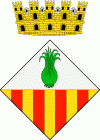Sabadell
 |
 |
Sabadell pioneered the Industrial Revolution in Catalonia with its textile mills, together with its archrival Terrassa. Thus, in the mid-19th century, it became the most important wool city in Spain, being nicknamed the "Catalan Manchester". Today many mills from that period can still be seen, with most of them having been refurbished as residential buildings or other services. Nowadays Sabadell is basically a commercial and industrial city; there are no significant agricultural activities.
Sabadell is an important communications point. Two motorways run beside the city: the C-58 (from Barcelona to Manresa) and the AP-7 (from France and Girona to Tarragona, Valencia, and Andalusia), and some roads link Sabadell with nearby cities and towns: Barcelona, Terrassa, Cerdanyola del Vallès, Sant Quirze del Vallès, Barberà del Vallès, Sant Cugat del Vallès, Castellar del Vallès, Sant Llorenç Savall, Granollers, Rubí, Sentmenat, and Molins de Rei.
A railroad line crosses the city (the Rodalies Barcelona line from Barcelona to Lleida) and another one terminates in the city (the FGC line from Barcelona to Sabadell via Sant Cugat del Vallès).
In Roman times, a little village called Arragone existed near where the church of La Salut now stands. This grew into the town called Arraona or Arrahona in the Middle Ages. Another little village was built just on the other side of the river. This second village, called Sabadell, located on a plain, began to grow and its population was about 600 people (152 houses) in 1378. Sabadell was enclosed by a wall, but due to population growth in the 16th century, some houses were built outside the wall. At that time the first textile industries appeared in the town, devoted especially to woolen clothing. The woolen industry grew over the next centuries, and in 1800 the town's population was about 2000 people.
The 19th century brought two important developments to the town: in 1856 the railway arrived, and in 1877 the town was dubbed a "city". In the 1897 census the population of the city was 23,044 people. The city had become the most important producer of woolen clothing in Spain, and these clothes achieved worldwide fame.
The modernisme movement (related to Art Nouveau) had an important influence in the architecture of the city in the early 20th century and distinctive buildings such as the modernista Hotel Suís (1902), Despatx Lluch (1908), and the Caixa d'Estalvis de Sabadell (1915), as well as the Torre de l'Aigua (1918) and the Mercat Central (1930), were built during the first half of the century.
In the early 20th century, Sabadell, with Terrassa, was the textile city par excellence, being the driving force of a territory poor in natural resources. The population was multiplied by eight, its industry boosted, particularly textiles and metals, and its economy was modernized in the service sector. Due to this industrial activity, Sabadell received massive waves of immigration in the 1950s, 1960s and early 1970s leading to uncontrolled urban expansion and the creation of some new neighborhoods such as Ca n'Oriac and Torre-Romeu.
There has always been since those days a rivalry between Terrassa and Sabadell, because both of them wanted to be capitals of the Vallés Occidental, as both were pretty relevant while this rise textile industry. Nowadays, still there are some popular sayings: "Sabadell mala pell" (Sabadell bad skin) and "Terrassa mala raça" (Terrassa bad race).
The growth of industry and population favored the emergence of an important workers’ movement, and Catalanist, socialist and anarchist parties were very influential up until the upheavals of the Spanish Civil War (1936–39). The victory of the Fascist faction in the war was a step backwards for the city, but in the fifties industry recovered and grew once more. Industries needed workers, and many people came from Andalusia, Murcia, Extremadura, Castile and other parts of Spain to work in the textile and the metal industry. Again, a new workers’ and Catalanist movement emerged, this time against Francisco Franco’s regime and with the support of the Roman Catholic Church.
Map - Sabadell
Map
Country - Spain
 |
 |
| Flag of Spain | |
Anatomically modern humans first arrived in the Iberian Peninsula around 42,000 years ago. The ancient Iberian and Celtic tribes, along with other pre-Roman peoples, dwelled the territory maintaining contacts with foreign Mediterranean cultures. The Roman conquest and colonization of the peninsula (Hispania) ensued, bringing the Romanization of the population. Receding of Western Roman imperial authority ushered in the migration of different non-Roman peoples from Central and Northern Europe with the Visigoths as the dominant power in the peninsula by the fifth century. In the early eighth century, most of the peninsula was conquered by the Umayyad Caliphate, and during early Islamic rule, Al-Andalus became a dominant peninsular power centered in Córdoba. Several Christian kingdoms emerged in Northern Iberia, chief among them León, Castile, Aragon, Portugal, and Navarre made an intermittent southward military expansion, known as Reconquista, repelling the Islamic rule in Iberia, which culminated with the Christian seizure of the Emirate of Granada in 1492. Jews and Muslims were forced to choose between conversion to Catholicism or expulsion, and eventually the converts were expelled through different royal decrees.
Currency / Language
| ISO | Currency | Symbol | Significant figures |
|---|---|---|---|
| EUR | Euro | € | 2 |
| ISO | Language |
|---|---|
| EU | Basque language |
| CA | Catalan language |
| GL | Galician language |
| OC | Occitan language |
| ES | Spanish language |
















